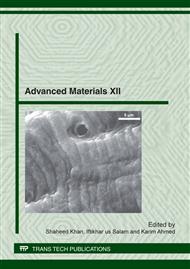[1]
Dimitrakopoulos, C. D., & Malenfant, P. R. L. Organic Thin Film Transistors for Large Area Electronics. Advanced Materials, 14(2), 99-117. (2002).
DOI: 10.1002/1521-4095(20020116)14:2<99::aid-adma99>3.0.co;2-9
Google Scholar
[2]
Grzegorz Darlinski, Ulrich Bottger, and Raine Waser. Mechanical force sensors using organic thin-film transistors, Journal of applied physics, Vol. 97 (2005).
DOI: 10.1063/1.1888046
Google Scholar
[3]
Mark Stewart, Robert S. Howell, Leo Pires, and Miltiadis K. Hatalis. Polysilicon TFT transistor technology for active matrix OLED displays, IEEE transactions on electron devices, Vol. 48 (2001).
DOI: 10.1109/16.918227
Google Scholar
[4]
M. Mizukami, N. Hirohata, T. Iseki, K. Ohtawara, T. Tada, S. Yagyu,T. Abe, T. Suzuki, Y. Fujisaki, Y. Inoue, S. Tokito, and T. Kurita. Flexible AM OLED panel driven by bottom contact OTFTs, IEEE electron device letters, Vol. 27 (2006).
DOI: 10.1109/led.2006.870413
Google Scholar
[5]
Soyoun Jun, Taeksoo Ji, Jining Xie and Vijay K. Varadan. Flexible strain sensors based on pentacene-carbon nanotube copmposite thin films, Proc. Of 7th IEEE international conference of nanotechnology, August 2-5, 2007, Hogkong.
DOI: 10.1109/nano.2007.4601212
Google Scholar
[6]
Khan MA, Gondal, MA Khawaja, EE. A gas Pressure Sensor based on ZrO2 Thin Films for use at high temperatures, Journal of Electronics, Vol. 87, pp.227-234.
DOI: 10.1080/002072100132363
Google Scholar
[7]
Chong Cheong Wei, Muhammad Yahaya and Muhamad Mat Salleh. Fabrication of Bi-Ti-O Thin Film Pressure Sensor prepared by electron beam evaporation method, Solid state Science and Technology, Vol. 13 (2005), pp.244-250.
DOI: 10.1109/smelec.2004.1620957
Google Scholar
[8]
Estibalitz Ochoteco, Tomasz Sikora, Haritz Macicior, Jose A. Pomposo, Hans Grande, Javier Rodríguez. From Conducting Polymers to Flexible Pressure Sensors: A Success History in Organic Electronics.
Google Scholar
[9]
I. Munanza and A. bonfiglio. Pressure sensing using a completely flexible organic transistor, Biosensors and Bioelectronics, Vol. 22 (2007), pp.2775-2779.
DOI: 10.1016/j.bios.2007.01.021
Google Scholar
[10]
Takao Someya and Takayasu Sakurai. Integration of Organic Field-Effect Transistors and Rubbery Pressure Sensors for Artificial Skin Applications, IEEE (2003).
Google Scholar
[11]
Mutabar Shah, Muhammad Hassan Sayyad and Khasan S. Karimov. Fabrication and Study of Nickel Phthalocyanine based Surface Type Capacitive Sensors, World Academy of Science, Engineering and Technology, (2008).
Google Scholar
[12]
Benny Joseph and C. S. Menon. Studies on the Optical Properties and Surface Morphology of Nickel Phthalocyanine Thin Films, E-journal of Chemistry, Vol. 4 (2007).
Google Scholar
[13]
K. Akimoto, S. Ishizuka, M. Yanagita, Y. Nawa, Goutam K. Paul, T. Sakurai. Thin film deposition of Cu2O and application for solar cells, Solar Energy, Vol. 80 (2006).
DOI: 10.1016/j.solener.2005.10.012
Google Scholar
[14]
Kh.S. Karimov, M. Saleem, Zubair Ahmad, M. Farooq, Z.M. Karieva, Adam Khan. Resistive and Capacitive Cu2O-PEPC Composite Based Displacement Transducer, Physica Scripta, Vol. 82 (2010).
DOI: 10.1088/0031-8949/82/06/065702
Google Scholar
[15]
Kh. S. Karimov, K. Akhmedov, I. Qazi, T. A. Khan, JOAM, Vol. 9 (2007), pp.2867-2872.
Google Scholar
[16]
Kh. Akhmedov, Synthesis, properties and application of carbazolile containing 254 polymers, Thesis of D. Sc., Academy of Sciences, Dushanbe, Tajikistan, (1998).
Google Scholar
[17]
J.D. Irwin. Basic Engineering Circuit Analysis, Sixth Edition. John Wiley & Sons, New York (1999).
Google Scholar
[18]
F. Gutman, L.E. Lyons, Organic semiconductor, Part A, (Robert E. Krieger Publishing Company, Malabar, Florida 1980), p.251.
Google Scholar
[19]
F. Gutman, H. Keyzer, L. E. Lyons, R.B. Somoano, Organic semiconductors, Part B, (Robert E. Krieger Publishing Company, Malabar, Florida 1983), p.122.
Google Scholar
[20]
N.F. Mott, E.A. Davis, Electronic Processes in Non-crystalline Materials, Oxford: Clarendon Press, 1971 , pp.96-123.
Google Scholar
[21]
C.J. Brabec, V. Dyakonov, J. Parisi, N.S. Sariciftci, Organic Photovoltaics. Concepts and Realization, Springer-Verlag, Berlin, Heidelberg, (2003).
DOI: 10.1007/978-3-662-05187-0
Google Scholar
[22]
H. Bottger, V.V. Bryksin, Hopping Conductions in Solids, Akademie Verlag, Berlin, (1985).
Google Scholar
[23]
R.G. Irvine, Operational Amplifiers Characteristics and Applications, Third Edition, Prentice Hall, Englewood Cliffs, NJ, (1994).
Google Scholar


